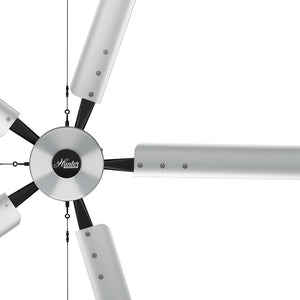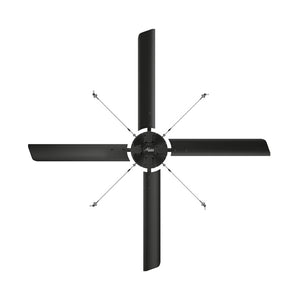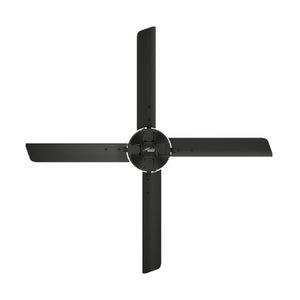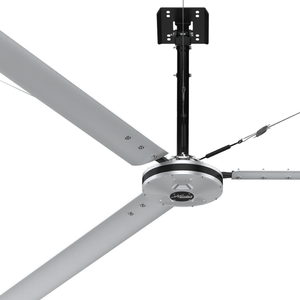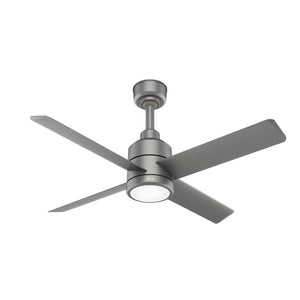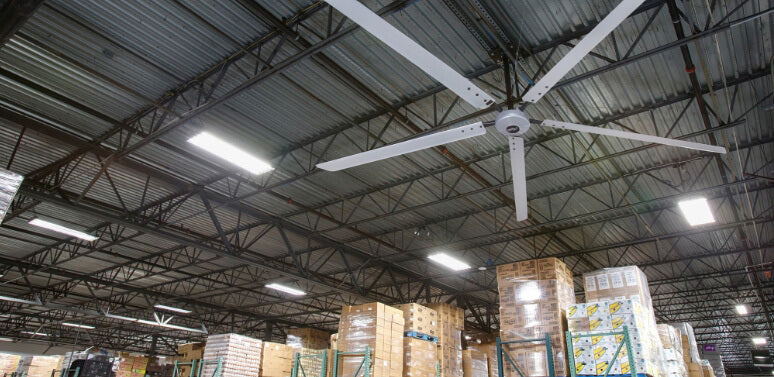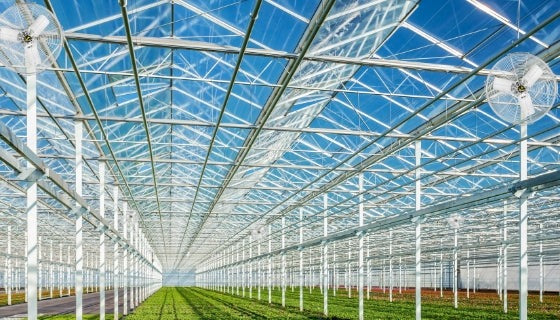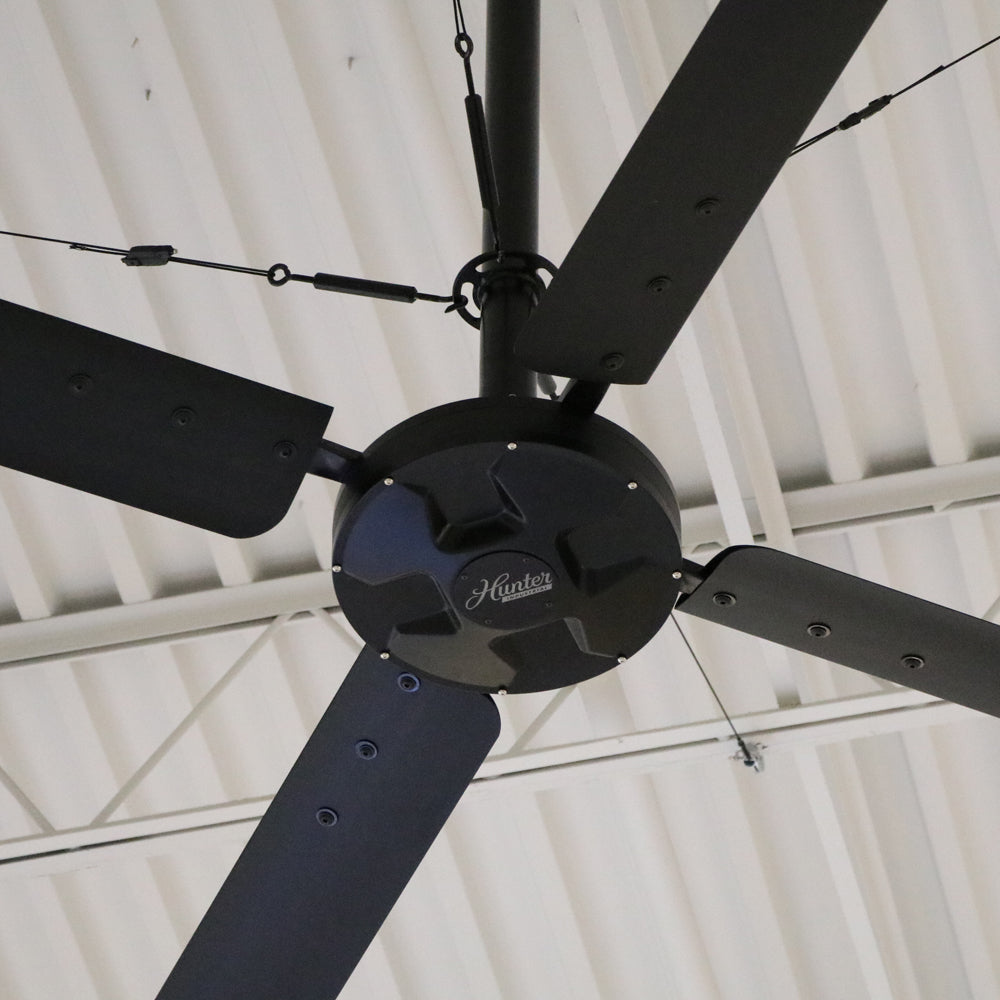Boasting the industry's top-tier warranty, swift lead times and exceptional customer service, Hunter Industrial & Commercial provides everything necessary to ensure your facility remains comfortable, secure, and efficient.
Benefits of Putting Fans in the Stands
Naturally, spectators want to be comfortable as they watch their team fight it out on the gridiron. We have the perfect solution, with cutting-edge industrial outdoor fans that provide these benefits to you and your fan base:
- Fan Movement: Our commercial ceiling fans excel at moving large volumes of air throughout the stadium. This constant airflow helps disperse stagnant air, reducing stuffiness and creating a fresher atmosphere.
- Improved Air Quality: Proper ventilation minimizes the accumulation of airborne contaminants, ensuring a healthier breathing environment for everyone in the stadium.
- Efficient Temperature Distribution: Hunter fans distribute warm or cool air evenly, eliminating temperature disparities within the stadium. This means no more uncomfortable hot spots or cold drafts, ensuring a consistent and pleasant experience for all.
- Energy Efficiency: By reducing the need for HVAC systems to work overtime, our fans contribute to significant energy savings, translating into lower operating costs for the stadium.
- Sustainable Solution: Our ceiling fans are designed with energy efficiency in mind, helping stadiums reduce their carbon footprint and meet environmental goals.
- Cost Savings: Lower energy consumption benefits the environment as well as your football stadium's budget, with reduced utility bills and long-term operational cost savings.
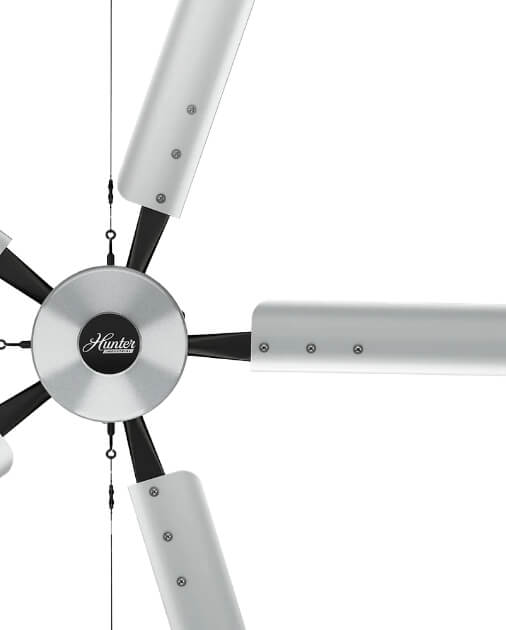

Size & Scale
Understanding the size and scale of your football field is paramount. Our commercial and industrial ceiling fans are engineered to provide the optimal airflow required for your specific stadium, ensuring that every seat in the house experiences the benefits of superior ventilation and temperature control.
- Fan Diameter: Choosing the right fan diameter is critical in maximizing the effectiveness of your commercial fans. The size of your stadium and the height of your ceilings will dictate the ideal fan size. Our experts will gladly assist you in determining the most appropriate fan diameter to achieve the desired airflow and comfort.
- Fan Quantities: The number of fans needed is related to the size and layout of your stadium. Our team will do a detailed assessment of your facility to recommend the optimal quantity of fans required for comprehensive coverage. From a small football field to massive NFL stadiums, we ensure that no corner is left untouched.
- Cubic Feet per Minute (CFM): CFM is a crucial metric in assessing the airflow capacity of our commercial ceiling fans. We'll work with you to calculate the required CFM based on the stadium's size, occupancy, and ventilation needs. This ensures that our fans are perfectly sized to deliver the proper airflow for a comfortable environment.
Installation of HVLS Fans in Football Stadiums
Stadiums, by their sheer size and design intricacies, present unique challenges when it comes to the installation of HVLS fans. Ensuring proper installation is crucial for your industrial stadium fans' operation and the safety of spectators, players, and staff. Here's a comprehensive guide on the various facets of ceiling fan installation in football stadiums.
Mounting Options for Stadium Ceiling Fans
Ensuring that your large-diameter ceiling fan is properly mounted is critical. Hunter Industrial & Commercial is proud to be the only HVLS fan manufacturer to offer an adjustable downrod. The adjustable downrod ensures that your HVLS ceiling fan is installed at the appropriate distance from the ceiling, avoids any potential obstructions, and is aligned at the perfect pitch every time.
Step-by-Step Overview of the Installation Process
- Assessment: Before any installation begins, it's essential to assess the location. This involves checking the ceiling structure, determining the fan's location, and ensuring there's an electrical connection available.
- Bracket Installation: The first step is to securely install the mounting bracket to the ceiling, which will hold the commercial fan's weight.
- Electrical Connections: Connect the fan's wiring to the stadium's electrical circuit. Employing qualified electricians familiar with stadium-grade installations for this task is recommended.
- Safety Testing: Once the industrial fans are installed, they should be tested for wobbles, noise, and any electrical issues to ensure safe operation.
Weight Considerations and Required Support Structures
- Structural Integrity: Football stadiums require fans that are considerably larger and heavier than standard ceiling fans. It's essential to ensure that the ceiling or the structure from which the fan hangs will support its weight.
- Reinforcement: In some cases, additional reinforcement might be needed, such as beams or specialized brackets, especially for particularly heavy or large fans.
- Regular Inspection: Hunter HVLS fans are designed to stand the test of time. However, it's important to periodically inspect and clean your fans and ensure that all connections are secure. A routine inspection ensures continued safety, which is why we offer our Annual Inspection and Cleaning Package.
Safety Considerations
The safety of ceiling fans in football stadiums is crucial because of the large crowds. Here's how we ensure it:
- Secure Anchoring: Fans must be firmly anchored to withstand strong winds, especially in open stadiums.
- Robust Construction: Choosing fans with strong construction reduces the risk of wear and tear over time.
- Regular Inspections: Check mounts, blade conditions, and safety features regularly for stability.
- Electrical Component Safety: Ensure fans' electrical parts are well-protected and insulated to prevent accidents.
EXPLORE OTHER CATEGORIES
Maintenance of Ceiling Fans in Football Stadiums:
For ceiling fans in football stadiums to operate efficiently and safely over the years, a systematic maintenance regimen is indispensable.
- Regularly clean the blades to ensure optimal airflow and prevent the accumulation of debris or dust that can imbalance the fan.
- Periodically check the fan's motor and bearings for signs of wear, ensuring smooth and noise-free operation.
- Inspect electrical connections for any loose wires or potential short circuits.
- Routinely check components like safety guards, mounts, and light kits to ascertain their structural integrity.
- Keep a maintenance schedule, preferably semi-annually, to aid in the timely detection of issues.
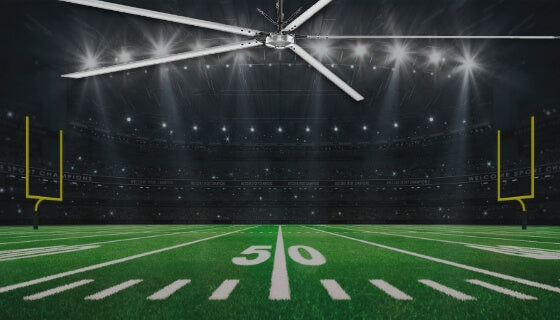

Selecting the Best Commercial Ceiling Fans for Your Stadium
Hunter provides a range of commercial ceiling fans to match your football stadium's specific airflow needs:
- Titan HVLS Ceiling Fan: With superior performance, the Titan HVLS fan extends up to 24 feet in diameter. Its design includes direct-drive motor systems, ensuring quiet operation.
- ECO HVLS Industrial Fan: Designed with expertise from aerospace professionals, the Hunter ECO fan offers an economical solution that's quiet and energy efficient.
- XP HVLS Ceiling Fan: Ideal for compact spaces like locker rooms, the Hunter XP fan guarantees year-round comfort, bolstered by its high-efficiency direct-drive motor.
- DDI HVLS Fan: The DDI fan – with aerodynamically refined blade sizes spanning 20 or 24 feet – is engineered for simplicity in operation and powerful air circulation.
Frequently Asked Questions About Ceiling Fans for Football Stadiums
Need more information about ceiling fans for football stadiums? We've answered a few commonly asked questions below, but feel free to contact us if you have any other concerns.
How Do Commercial Ceiling Fans Impact the Stadium's Overall Energy Consumption?
What Precautions Should Be Taken for Fans Installed in Open-Air Stadiums?
Premium Ceiling Fans for Football Stadiums Are Something to Cheer About
Don't let discomfort overshadow the thrill of the game. Invest in Hunter ceiling fans for football stadiums to ensure optimal ventilation and enhanced spectator comfort. Beyond just cooling, our range of fans offers energy efficiency, remote integration and aesthetic designs tailored for grand arenas. Elevate every match, concert, or event at your stadium by incorporating the best in air circulation technology. Reach out today!
up your game today!
Start Your Hunter Industrial Fan Journey
At Hunter Industrial We Know Air. Our Industrial And Commercial Fans Are Carefully Crafted To Meet The Needs Of Your Detailed And Delicate Industry. Our Experts Are Ready To Work With You To Design A Perfect Airflow Plan To Enhance Your Space. Fill Out The Form To Connect With Us Today.
Like Talking To Real People?
So do we. Reach a Hunter Industrial sales rep

 100% Secure Payments
100% Secure Payments